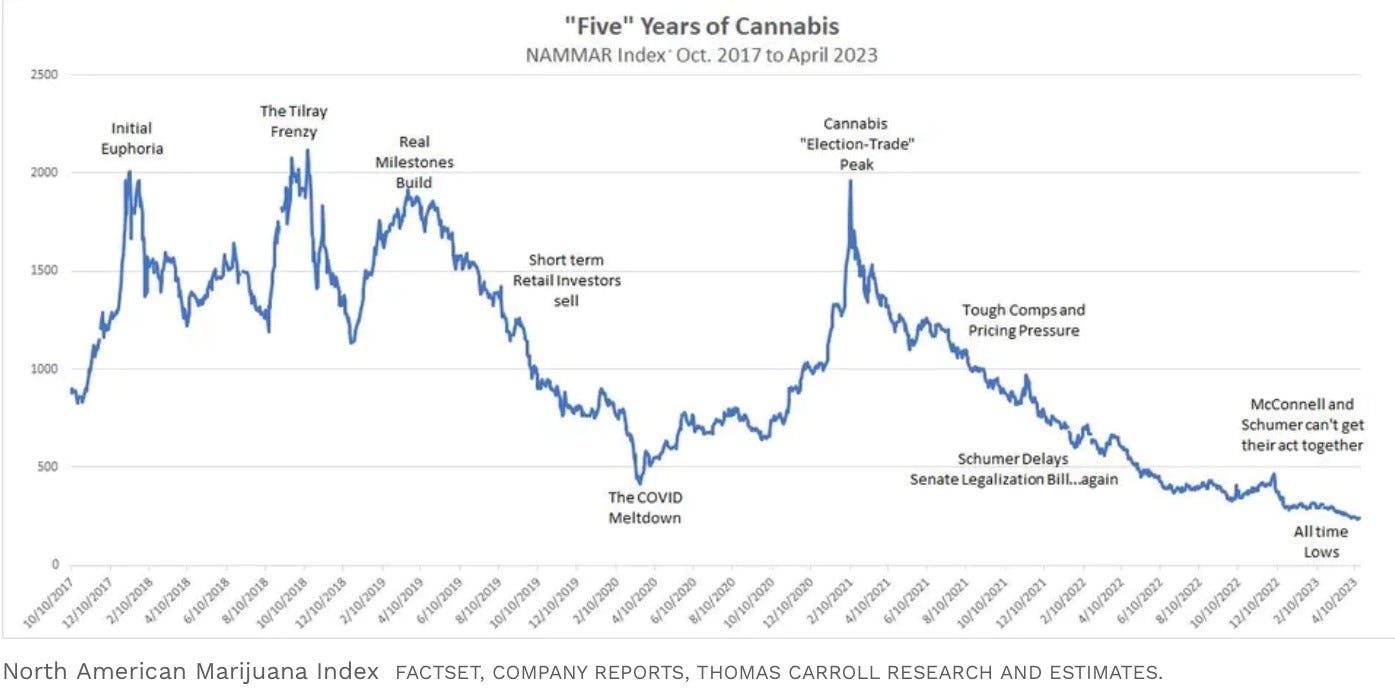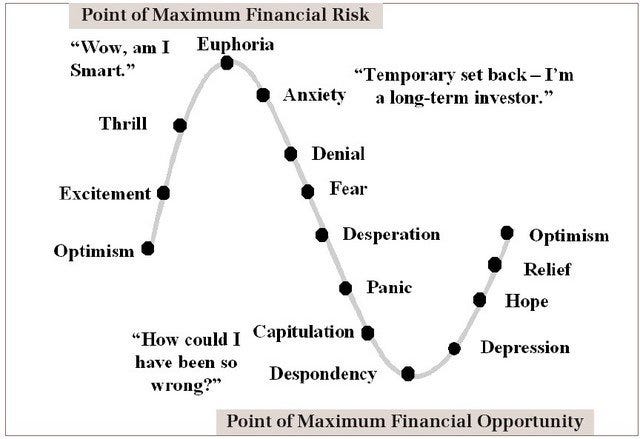I often scribble random thoughts, themes and topics that eventually weave their way into these monthly columns. That process, constant through the years, has helped me contextualize the landscape as we collectively attempt to navigate the vicissitudes of this emerging market: the ups, downs and more recently, the vicious sector Exodus.
In our February letter to investors, we shared:
We entered 2023 with the view that if the U.S. cannabis industry could navigate the Q1 hangover of the December crash, sector-specific news should begin to support higher stock prices into April. That continues to be our view, although this environment is not without its challenges as the recent macroeconomic crosscurrents have been fiercer than usual.
As investors attempt to reconcile the Federal Reserve’s inflation mandate with structural cracks that recently emerged in banking, we’re reminded that 1. U.S. cannabis isn’t part of mainstream banking yet and as such, may be oddly insulated, 2. if the U.S. banking system needs billions of dollars of capital deposits overnight, we know one of industry ready to help, and 3. if capital seeks fixed-income safety, the cost of that capital will become less expensive.
In our March letter, we continued:
The reason so many babies have been tossed out with the bathwater is that nobody believes federal law will change anytime soon: “limited near-term prospects” (Raymond James/Piper Sandler), “Nobody cares” (Needham), "nothing in near future" (Wedbush), ‘Maybe 2H23’ (Cantor), and “nothing in foreseeable future" (Cowen, before dropping coverage and custody when TD Bank deal closed).
We know now that SAFE Banking was in fact teed-up several weeks ago until the banking crisis stole the Senate’s attention. That surprised some, but not us, as there is both the political will and a viable pathway for near-term Federal reform, even if that process was pushed out a month or so beyond our original expectations.
[note: the reason I’ve been laser-focused on banking (and other passable, incremental) reform these last few years is because after 34 years in financial markets, I understand that without plumbing (custody), there can be no liquidity and without capital flows, the industry would atrophy over time, as it has.]
For the first half of April, I struggled to find any semblance of progress as the sector continued to melt lower. The sequence of events that we expected might jolt the space higher hadn’t materialized and sector sentiment continued to devolve. Many openly questioned if the industry would even survive as prominent U.S banks abandoned the group, no longer willing to wait for banking revenues to justify research expenditures.
As I made my way toward Washington D.C. for The National Cannabis Policy Summit Congressional Forum at the U.S. Capitol Building on 4/20, I read that it had been over 800 days since the sector had topped. “Be the change you hope to see,” I whispered to myself as Amtrak hummed southbound, unsure if even I believed myself at that point.
While we knew substantive legislative initiatives wouldn’t be announced at that event, several clues were offered in our nation’s capital. Sen Majority Leader Chuck Schumer suggested that while he continues to fight for comprehensive reform and social justice provisions, he now understands that access to banking is a necessary first step.
[note: we fully expect #HOPEAct, which encourages states to expunge non-violent cannabis offenses, to be added as companion legislation, as it was last year]
Additionally, Rep Dave Joyce and Sen John Hickenlooper laid the groundwork for the next legislative push, one predicated on states’ rights which would afford federal protections for state-legal cannabis businesses, address the 280E tax conundrum and include further criminal justice components.
Those efforts will continue to progress, as will the Garland Memo and the eventual and heretofore expedited HHS review decision.
A few days after I returned from DC, the headlines began to pick up in pace:
GOP Congressman and AOC Refile Bill to Incentivize State-Level Marijuana Expungements (4/18)
Bipartisan US House, Senate Lawmakers Reintroduce Marijuana Banking Bill (4/26)
Senators Celebrate Bipartisan Marijuana Banking Bill Introduction (5/1)
Key Senate Committee Schedules Marijuana Banking Hearing next week (5/4)
Senators Push For Marijuana Industry Access To Federal Small Business Loans And Services (5/9)
Interestingly, after so many false starts and empty political promises, many if not most of the analysts and investors who remain in the game reacted the same:
Recency bias, or perhaps repetitious mental anguish and financial pain, has seemingly ushered in the other side of euphoria and a bitter disdain for even the specter of a seismic shift in the cannabis landscape.
This transition, if that’s what we’re witnessing, will take some time and higher prices to convince investors that this isn’t just another in a long series of vicious head-fakes.
The fact nobody thinks we’re going to see federal reform is incredibly bullish, as long as it happens; it also creates duration risk as political processes takes time, by design, and most people won’t believe it until they actually see it.
Quick Metric Check:
Fundamentals: Despite robust YoY unit volume increases across the category, price normalization, input cost inflation and limited access to capital (along w the onerous federal tax regime) continues to separate the haves vs. have-nots. Q1 results have been uneven and muted, with tempered guidance, although expectations may have already discounted many of those concerns, at least for those best-positioned to succeed.
We continue to believe Q123 will be the industry earnings trough as attrition among operators and CAPEX reductions buoy prices across select geographies, seasonality kicks-in, optimization flows through and new states onboard.
Given the tax structure and capital constraints, large-cap US MSOs now trade at a consensus 2023 EV/EBITDA multiple of 5.7X, compared to Alcohol, CPG, and Tobacco multiples of 12.6X, 17.0X, and 8.9X, respectively, per ATB Capital Markets.
Technical analysis: Given the duration and severity of the downdraft in the sector, there is a lot of work to be done to improve the charts, beginning with the ability to recapture lost levels and moving averages that broke on the way down.
As price action improves and levels are reclaimed, technical buyers—to the extent they can access the underlying securities directly or use MSOS or another NYSE-listed U.S. canna ETF as a proxy —should emerge at higher levels.
The inability for most investors (or any institution) to access these securities is a large reason why we continue to monitor plant-touching volume trends, which have started to accelerate in recent weeks, from ~$15-20M daily notional for most of April to ~$75- $100M in early May.
Structural: the obvious catalysts are banking (to facilitate custody solutions on top of the obvious safety implications) and addressing 280E (via next legislative push or HHS review) but there are other developments in the works, such as the ability to list on the TSX. Additionally, if forced liquidations were triggered by Cowen’s abrupt exit from the space, those would have concluded by month-end.
Psychology: If denial, migration and panic characterize stock market phases, it’s easy to peg where cannabis investors are on that continuum after Cowen, Cantor and BTIG all shuttered their respective cannabis coverage. Given the duration of the drawdown, this sentiment may be warranted, but it is also intriguing given recent evolutions and the potential value unlock and rerating that awaits federal reform.
To be sure, a slew of risks remain for our economy, financial markets and this sector, in no particular order, and of course, any successful legislation is predicated on having a functioning government (resolution on the debt ceiling).
Still, given momentum at the state level—and the sudden rush of federal movement— it has become self-evident that the cannabis industry will be a staple of the American economy for years to come, even if the growing pains promise to continue.
Be the Change you Hope to See
A few weeks ago, we launched The Mission Green Alliance (MGA), an industry-wide collaboration that allows consumers of legal cannabis the option to round-up to the nearest dollar or otherwise donate to The Weldon Project and Mission [Green] with the intention to allow consumers to be the change they hope to see.
Funds raised through this channel will be used to effect legislative change at the federal level, support congressional outreach initiatives and liaise with the White House regarding the ongoing expedited scheduling review.
The Mission Green Alliance aims to bring together leaders from both sides of the aisle to effect federal cannabis reform. We are working directly with entertainers, key advocacy groups, formerly incarcerated individuals, business leaders, and cannabis entrepreneurs to support proposals that have the highest likelihood of success.
We wish to thank our partners for their support while we encourage any and all solid citizens to help support Weldon Angelos in his mission to effect positive change.
More information on how to contribute as an individual, dispensary or vendor here; and if you would like to obtain your Mission [Green] Vangst badge, please click here.
In other late-breaking April sector news:
Delaware became the 22nd state to legalize adult-use
NBA players will no longer be prohibited for marijuana under the new seven-year Collective Bargaining Agreement; Connecticut dismissed more than 1,500 pending marijuana cases
The Chicago Cubs is the first Major League Baseball team to partner with a CBD company
German Officials Unveil Revised Plan to Legalize Marijuana
Minnesota is Preparing to Legalize Adult-Use Cannabis
The Texas House of Representatives Voted to Decriminalize Marijuana, sending it to the Senate
Georgia issued the state's first medical marijuana dispensary licenses.\
Good luck out there and remember to be good to others and better to yourself.










